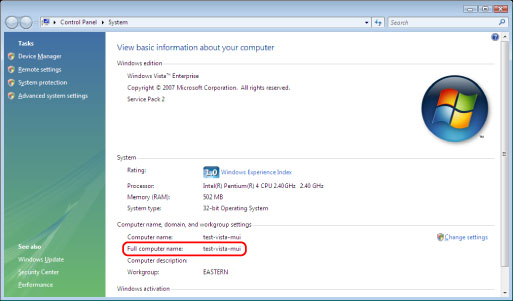|
IMPORTANT
|
|
The use of Windows XP Professional/Server 2003/Server 2008/Vista/7/Server 2008 R2 as an FTP server requires the installation of IIS. If IIS is not installed in the computer you are using, you will need to install the version of IIS for the operating system you are using before entering these settings. (See "Sending Data.") For installation procedures, see the manuals provided with your operating system.
User authentication for access to FTP servers is performed using the local account database of Windows XP Professional/Server 2003/Server 2008/Vista/7/Server 2008 R2 used as the FTP server. Therefore, it is not possible to use the account of a domain user registered in Windows XP Professional/Server 2003/Server 2008/Vista/7/Server 2008 R2 to send data directly from the machine to FTP servers in other domains.
|




|
NOTE
|
|
In the Active Directory environment, the procedures for setting up users differ from the above. For more information, see the Windows manual.
|
|
[Full computer name]:
|
starfish.organization.company.com
|
|
<Protocol:>:
|
FTP
|
|
[Host Name]:
|
starfish.organization.company.com
|
|
[Folder Path]:
|
share
|
|
[User Name]:
|
User name entered in step 5
|
|
[Password]:
|
Password for the above user
|

|
IMPORTANT
|
|
To use the full computer name, which was confirmed in step 4, as the host name for [Host Name] as shown in the above example, it is necessary to use a DNS server. (This applies even if the machine and the FTP server are in the same subnet.) If no DNS server is available, the setting for [Host Name] should be specified using the IP address of the FTP server.
Up to 128 alphanumeric characters can be entered for [Host Name] on the control panel. Also, up to 255 alphanumeric characters can be entered for [Folder Path]. Specify the server settings within the character limits.
If you change the language of the touch panel display, [Host Name] and [Folder Path] may not appear correctly.
If you want to send to an IPv4 host using an FTP port other than port 21, set [Host Name] using the following format:
<IPv4 address of FTP server>:<Port number> Example: 192.168.1.21:21000 To send to an IPv6 host, set [Host Name] using the following format:
<IPv6 address>:<Port number> Example: [5aed:90a0:bc05:01d2:568a:2fc0:0001:12ee]:21000 |
|
Host Name:
|
starfish
|
|
Domain:
|
organization.company.com
|
|
<Protocol:>:
|
FTP
|
|
[Host Name]:
|
starfish.organization.company.com
|
|
[User Name]:
|
User name entered in step 1
|
|
[Password]:
|
Password for the above user
|
|
IMPORTANT
|
|
To use the host name of the above example for [Host Name], it is necessary to use a DNS server. (This applies even if the machine and the FTP server are in the same subnet.) If no DNS server is available, the setting for [Host Name] should be specified using the IP address of the FTP server.
Up to 128 alphanumeric characters can be entered for [Host Name] on the control panel. Also, up to 255 alphanumeric characters can be entered for [Folder Path]. Specify the server settings within the character limits.
If you change the language of the touch panel display, [Host Name] and [Folder Path] may not appear correctly.
If you want to send to an IPv4 host using an FTP port other than port 21, set [Host Name] using the following format:
<IPv4 address of FTP server>:<Port number> Example: 192.168.1.21:21000 To send to an IPv6 host, set [Host Name] using the following format:
<IPv6 address>:<Port number> Example: [5aed:90a0:bc05:01d2:568a:2fc0:0001:12ee]:21000 |
|
<Protocol:>:
|
FTP
|
|
[Host Name]:
|
IP address of Macintosh
|
|
[User Name]:
|
User name entered in step 3
|
|
[Password]:
|
Password for the above user
|

|
IMPORTANT
|
|
Up to 255 alphanumeric characters can be entered for [Folder Path] on the control panel.
If you change the language of the touch panel display, [Host Name] and [Folder Path] may not appear correctly.
If you want to send to an IPv4 host using an FTP port other than port 21, set [Host Name] using the following format:
<IPv4 address of FTP server>:<Port number> Example: 192.168.1.21:21000 To send to an IPv6 host, set [Host Name] using the following format:
<IPv6 address>:<Port number> Example: [5aed:90a0:bc05:01d2:568a:2fc0:0001:12ee]:21000 |
|
NOTE
|
|
If you are using Windows Vista, a dialog box may appear while you are performing the procedure. In this case, enter a user name and password. For more information, see the manuals provided with the operating system.
|